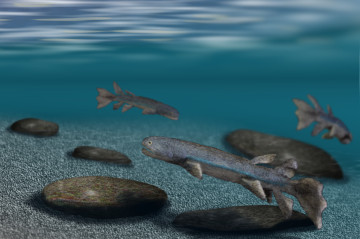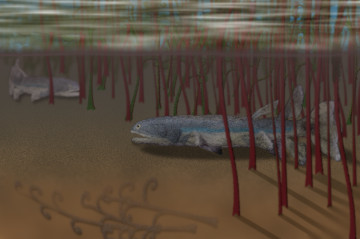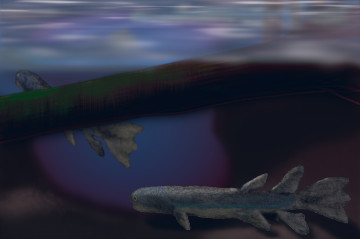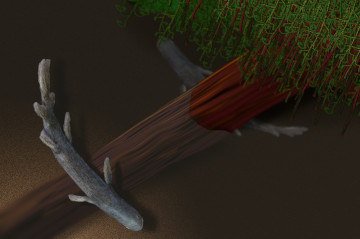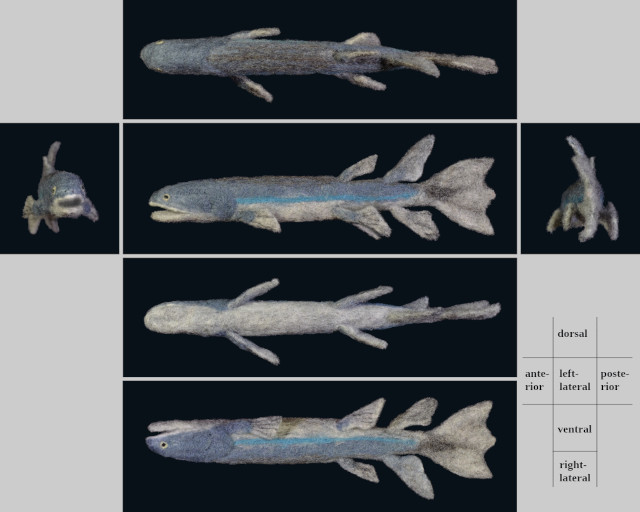Eusthenopteron foordi
Eusthenopteron foordi is a fossil fish with fleshy fins (lobe-finned fishes, Sarcopterygii) of the Late Devonian, and has been collected from Miguasha, Canada 2), 4). Its generic name "Eusthenopteron" means "stout fins" in Greek, and its specific name is derived from its discoverer 8).
Erik Jarvik, Swedish palaeontologist, investigated on Eusthenopteron over many decades, contributing to make it a household name 3), 6).
Eusthenopteron has a pair of "internal nostrils (narises)" (choanae), which is a character shared by the tetrapods (the land vertebrates) 6), 9). The air flows through the narises into the nasal cavilty, subsequently moves through the choanae into the oral chamber, so Eusthenopteron may have be able to inhale air even if its mouth was closed.
Eusthenopteron had no sufficient adaptation for very shallow water environment, though the closest sarcopterygian to the tetrapoda, indeed they lived a satisfying life as fishes 6). Presumably, Eusthenopteron was an ambush predator 10), and could capture large prey with suction and biting 7).
Miguasha cliff, where the fossils have been collected from, seems to be freshwater origin, then Eusthenopteron may have lived in freshwater environments, or brackish-water, such as near estuaries 2), 5).
Eusthenopteron is classified to the Family Tristichopteridae, which is relatively closer to the tetrapoda crown group (the land vertebrates) among the tetrapodomorph, which contains the tetrapoda crown and its stem 1), 2), 6). So, Eusthenopteron is closer to the land vertebrates than the lung fishes or the coelacanth (Latimeria) 1), nevertheless, as described above, Eusthenopteron is entirely aquatic.
created in June - August 2021.
References:
- Ahlberg PE, Johanson Z (1998) Osteolepiforms and the ancestry of tetrapods. [abstract] Nature 395: 792 - 794 (DOI:10.1038/27421) (The full-text was reffered to ResearchGate.)
- Clack JA (2007) Devonian climate change, breathing, and the origin of the tetrapod stem group. Integra. Comp. Biol. 47(4):510 - 523 (DOI: 10.1093/icb/icm055.)
- Devonian Times - More About Lobe-Fins: Sarcopterygii (Retrieved 9 August 2021.)
- Geological Survey of Canada. Past lives: Chronicles of Canadian Paleontology. 22. Eusthenopteron - the Prince of Miguasha (Retrieved 24 July 2021.)
- From water to land - Miguasha National Park - (Retrieved 25 July 2021.)
- Merck J (2021) Accidental Land Animals. GEOL 431 Vertebrate Paleobiology, Spring Semester 2021. Department of Geology, University of Maryland. (Retrieved 22 July 2021.)
- Porro LB, Rayfield EJ, Clack JA (2015) Computed tomography, anatomical description and three-dimensional reconstruction of the lower jaw of Eusthenopteron foordi Whiteaves, 1881 from the Upper Devonian of Canada. Palaeontology 58(6): 1031 - 1047 (DOI: 10.1111/pala.12192.)
- Whiteaves JF (1881) On some remarkable fossil fishes from the Devonian rocks of Scaumenac Bay, in the Province of Quebec. Annals and Magazine of Natural History 8(44): 159-162 (DOI:10.1080/00222938109487434.)
- Zhu M, Ahlberg PE (2004) The origin of the internal nostril of tetrapods. [abstract] Nature 432: 94 - 97 (DOI:10.1038/nature02843.) (The full-text was reffered to ResearchGate.)
- Zylberberg L, Meunier FJ, Laurin M (2010) A microanatomical and histological study of the postcranial dermal skeleton in the Devonian sarcopterygian Eusthenopteron foordi. Acta Palaeontologica Polonica 55(3): 459 - 470 (DOI:10.4202/app.2009.1109.)

